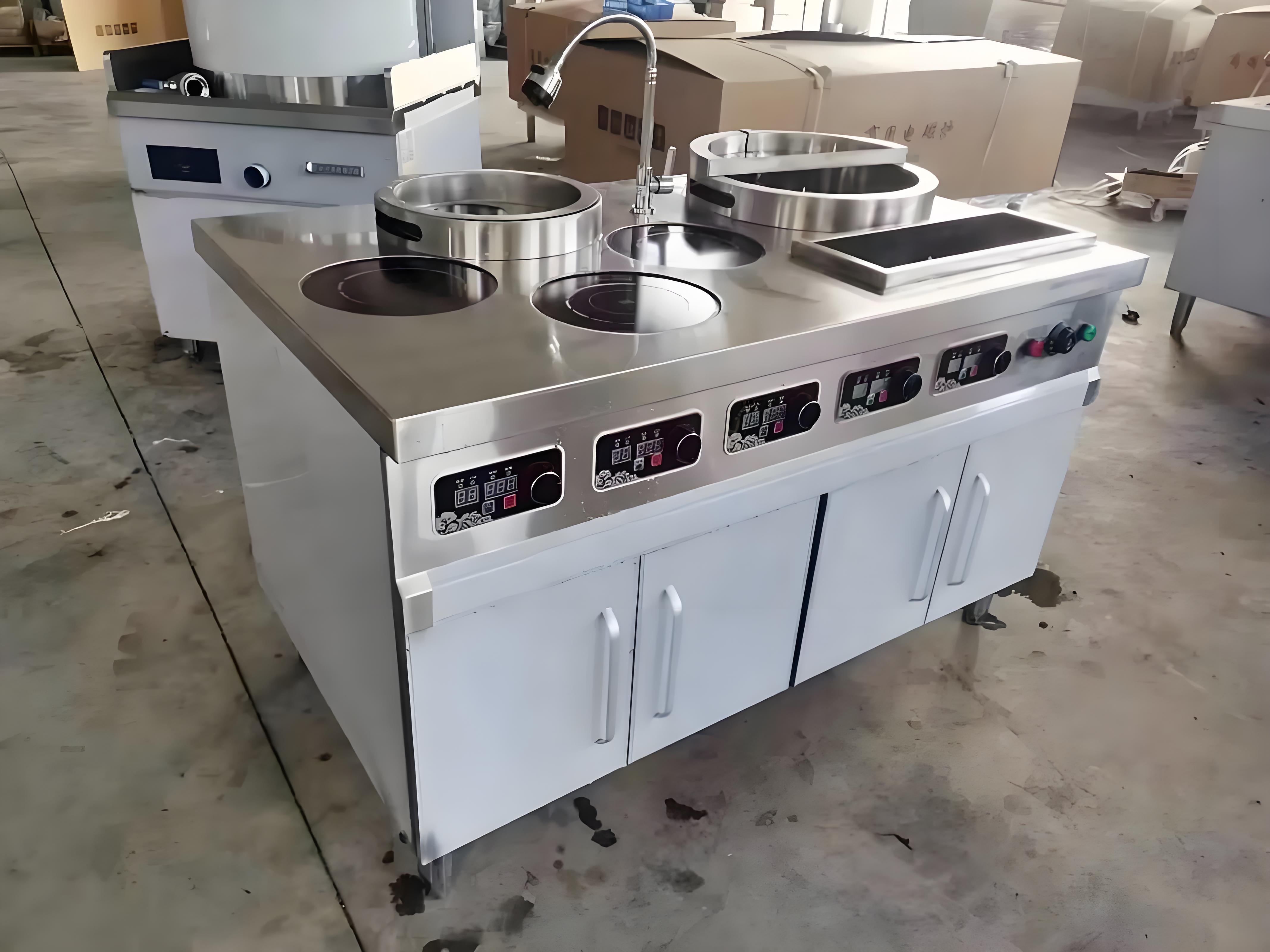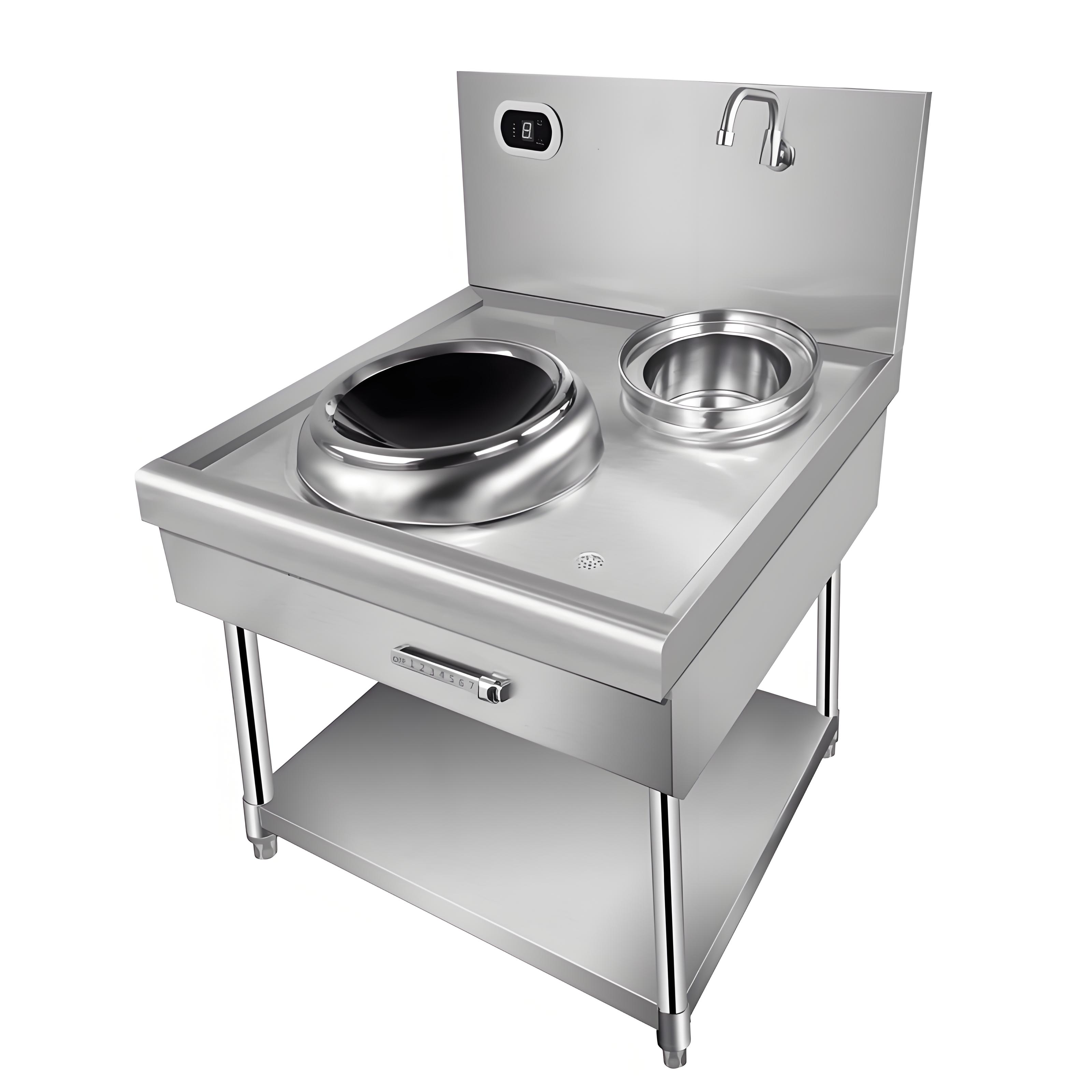In a busy commercial kitchen, efficiency and reliability are critical, and a commercial induction cooker failure can cause business disruption. A common problem for many kitchen staff and technicians is the inability to restart after a power outage. As someone who has been in the commercial kitchen equipment industry for many years, I will guide you in diagnosing and resolving this annoying problem.

Understanding the Problem
Before diving into solutions, it’s essential to understand why a commercial induction cooker might fail to restart after a power loss. There could be several reasons, ranging from simple electrical issues to more complex internal component failures. Here are some of the most common culprits:
Power Supply Issues: A sudden power loss or surge can sometimes damage the cooker’s power supply unit, preventing it from restarting.
Circuit Breaker Tripping: If the cooker draws too much current or if there’s a short circuit, the circuit breaker might trip, cutting off power to the unit.
Internal Component Failure: Components like the control board, power module, or sensors can fail due to age, wear and tear, or electrical damage.
Software or Firmware Glitches: Modern induction cookers often rely on software or firmware to function. A power loss can sometimes corrupt these programs, leading to startup issues.
Overheating Protection: Some cookers have built-in overheating protection mechanisms that can prevent the unit from restarting if it detects excessive heat.
Step-by-Step Troubleshooting Guide
Now that we’ve identified some potential causes, let’s walk through a step-by-step troubleshooting process to help you diagnose and fix the issue.
Step 1: Check the Power Supply
Action:
Verify Power Connection: Ensure that the cooker is properly plugged into a working electrical outlet. Check the outlet for any signs of damage or loose connections.
Test with Another Device: Plug in another device, like a lamp or a small appliance, to the same outlet to verify that it’s receiving power.
Check Circuit Breaker: Locate the circuit breaker panel and check if the breaker for the cooker’s outlet has tripped. If it has, reset it and try restarting the cooker.
Potential Outcomes:
If the outlet is not working, you may need to call an electrician to repair or replace it.
If the circuit breaker trips again after resetting, there could be a more serious electrical issue that requires professional attention.

Step 2: Inspect the Cooker’s External Components
Action:
Visual Inspection: Look for any visible signs of damage, such as frayed wires, loose connections, or burnt components.
Check Control Panel: Ensure that the control panel is clean and free of debris. Sometimes, spills or moisture can cause the panel to malfunction.
Test Buttons and Switches: Press all the buttons and switches on the control panel to ensure they’re functioning properly. If any feel sticky or unresponsive, they may need to be cleaned or replaced.
Potential Outcomes:
If you find any visible damage, it’s best to contact a professional technician to repair or replace the affected components.
If the control panel is dirty or has spills, clean it gently with a damp cloth and mild detergent. Avoid using harsh chemicals or abrasive materials that could damage the panel.
Step 3: Check Internal Components (If Accessible)
Action (Note: This step requires some technical expertise and may void the warranty if not performed by a certified technician):
Open the Cooker: If possible, carefully open the cooker’s casing to access the internal components. Refer to the user manual or manufacturer’s instructions for guidance on how to do this safely.
Inspect Power Supply Unit: Look for any signs of damage, such as burnt components or loose connections. Use a multimeter to test the voltage output of the power supply unit if you’re comfortable doing so.
Check Control Board and Sensors: Inspect the control board and sensors for any signs of damage or corrosion. Look for loose connections or burnt components that may need to be replaced.
Test Fans and Cooling System: Ensure that the fans and cooling system are functioning properly. Overheating can cause the cooker to shut down and prevent it from restarting.
Potential Outcomes:
If you find any damaged components, it’s best to contact a professional technician to repair or replace them. Attempting to repair or replace internal components without proper training and tools can be dangerous and may cause further damage to the cooker.
If the fans or cooling system are not functioning properly, they may need to be cleaned, repaired, or replaced.

Step 4: Reset the Cooker
Action:
Unplug the Cooker: Disconnect the cooker from the power source and wait for at least 30 seconds to allow any residual electrical charge to dissipate.
Press Reset Button (If Available): Some induction cookers have a reset button that can be pressed to restore the unit to its default settings. Refer to the user manual or manufacturer’s instructions to locate and use this button if available.
Plug the Cooker Back In: After waiting for 30 seconds, plug the cooker back into the power source and try restarting it.
Potential Outcomes:
If the cooker restarts successfully after resetting, the issue may have been caused by a temporary software or firmware glitch.
If the cooker still fails to restart, there may be a more serious issue that requires further diagnosis and repair.
Step 5: Contact a Professional Technician
Action:
Seek Professional Help: If you’ve followed all the above steps and the cooker still fails to restart, it’s time to contact a professional technician. They have the expertise, tools, and experience to diagnose and repair complex issues with commercial induction cookers.
Provide Relevant Information: When contacting the technician, provide them with as much information as possible about the issue, including when it started, any error messages displayed, and any steps you’ve already taken to troubleshoot the problem.
Potential Outcomes:
The technician will be able to diagnose the issue accurately and provide you with a solution. This may involve repairing or replacing damaged components, updating software or firmware, or performing other necessary maintenance tasks.
Depending on the severity of the issue and the age of the cooker, the technician may recommend replacing the unit entirely if it’s more cost-effective to do so.

Preventive Maintenance Tips
To avoid similar issues in the future, here are some preventive maintenance tips to keep your commercial induction cooker in top condition:
Regular Cleaning: Clean the cooker regularly to prevent spills and debris from accumulating on the control panel, fans, and other components. Use a damp cloth and mild detergent to wipe down the surfaces, and avoid using harsh chemicals or abrasive materials.
Check Electrical Connections: Periodically check the electrical connections to ensure they’re tight and secure. Loose connections can cause electrical issues and prevent the cooker from functioning properly.
Monitor Temperature: Keep an eye on the cooker’s temperature to prevent overheating. If the cooker seems to be running hotter than usual, it may indicate a problem with the cooling system or other components.
Follow Manufacturer’s Instructions: Always follow the manufacturer’s instructions for use, maintenance, and troubleshooting. This will help ensure that you’re using the cooker correctly and that you’re aware of any potential issues or warnings.
Schedule Regular Maintenance: Consider scheduling regular maintenance checks with a professional technician to keep the cooker in optimal condition. They can perform routine inspections, cleanings, and repairs to prevent issues from occurring in the first place.
Common Issues and Solutions Table
To help you quickly identify and resolve common issues with commercial induction cookers, here’s a simplified table summarizing some of the most common problems and their solutions:
| Issue | Possible Cause | Solution |
|---|---|---|
| Cooker fails to restart after power loss | Power supply damage, circuit breaker tripped, internal component failure | Check power supply, reset circuit breaker, inspect internal components, contact technician |
| Control panel unresponsive | Spills, moisture, loose connections | Clean control panel, check connections, contact technician if necessary |
| Cooker overheats | Cooling system failure, blocked fans | Clean fans and cooling system, check for blockages, contact technician |
| Error messages displayed | Software/firmware glitch, sensor failure | Reset cooker, update software/firmware, inspect sensors, contact technician |
| Unusual noises or vibrations | Loose components, motor failure | Tighten loose components, check motor, contact technician |
Conclusion: Restoring Your Commercial Induction Cooker to Optimal Performance
Dealing with a commercial induction cooker that fails to restart after a power loss can be a frustrating and time-consuming experience. However, by following the step-by-step troubleshooting guide outlined in this article, you can diagnose and resolve the issue efficiently and effectively. Remember to prioritize safety at all times and seek professional help if you’re unsure about any aspect of the repair process.
With proper maintenance and care, your commercial induction cooker can provide reliable and efficient performance for years to come. By staying vigilant and addressing issues promptly, you can minimize downtime and keep your kitchen operations running smoothly.

Related Questions and Answers
Q1: Can I repair a commercial induction cooker myself?
A1: While some minor issues, like cleaning the control panel or checking electrical connections, can be done by yourself, it’s generally recommended to contact a professional technician for more complex repairs. Attempting to repair internal components without proper training and tools can be dangerous and may cause further damage to the cooker.
Q2: How often should I schedule maintenance for my commercial induction cooker?
A2: It’s a good idea to schedule regular maintenance checks with a professional technician at least once a year. However, the frequency may vary depending on the usage and condition of your cooker. If you notice any unusual noises, error messages, or performance issues, it’s best to contact a technician immediately.
Q3: What should I do if my commercial induction cooker is still under warranty?
A3: If your cooker is still under warranty, contact the manufacturer or authorized service center for assistance. Attempting to repair the cooker yourself or using non-authorized parts may void the warranty.
Q4: How can I prevent power surges from damaging my commercial induction cooker?
A4: To prevent power surges from damaging your cooker, consider installing a surge protector or uninterruptible power supply (UPS) system. These devices can help regulate the voltage and protect your cooker from electrical damage.
Q5: Can I upgrade the software or firmware on my commercial induction cooker?
A5: Some induction cookers allow for software or firmware upgrades to improve performance or add new features. Check the manufacturer’s website or contact their customer support for information on available upgrades and how to install them. Always follow the manufacturer’s instructions carefully to avoid any issues.





